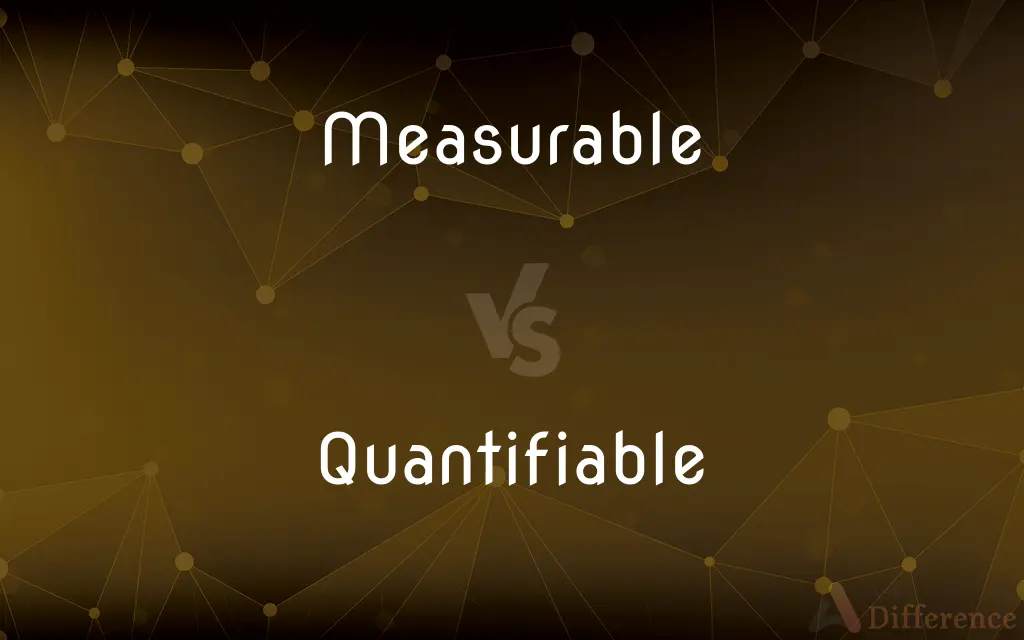Measurable vs. Quantifiable — What's the Difference?
Edited by Tayyaba Rehman — By Maham Liaqat — Updated on April 1, 2024
Measurable refers to the ability to determine the extent, dimensions, or quantity of something using standard units, while quantifiable focuses on the capability to express or measure something in numerical terms.

Difference Between Measurable and Quantifiable
Table of Contents
ADVERTISEMENT
Key Differences
Measurable attributes are those that can be directly measured using tools or standard units, providing precise and often physical dimensions. For instance, the length of a table can be measured in inches or centimeters with a ruler. On the other hand, quantifiable attributes might not always involve direct measurement but can be converted into numbers to assess their size, amount, or degree. This includes concepts like customer satisfaction, which can be quantified through surveys and statistical analysis.
While measurable factors often pertain to tangible, physical properties that can be observed and recorded using standard measurement units, quantifiable factors extend to both tangible and intangible aspects. Quantifiable data can include abstract qualities or effects that are numerically represented after analysis, like the number of social media likes indicating popularity.
In the realm of science and engineering, measurable quantities are crucial for experiments and designs that require precise physical measurements, such as distance, mass, or temperature. Quantifiable data, whereas, plays a significant role in fields like marketing and sociology, where the intensity or magnitude of phenomena is expressed numerically, even if they are not physically measurable.
The process of measurement typically implies a direct interaction with the object or phenomenon to obtain a numerical value, utilizing tools or instruments. Conversely, quantification can involve indirect methods, such as statistical modeling or surveys, to assign numerical values to observations or responses.
Both measurable and quantifiable data are essential for research, analysis, and decision-making across various domains. However, the choice between them depends on the nature of the data or phenomenon being studied. Measurable data is sought for physical characteristics, while quantifiable data is used for abstract concepts that require numerical expression for analysis.
ADVERTISEMENT
Comparison Chart
Definition
Can be determined or assessed using standard units or tools.
Can be expressed or measured in numerical terms, not limited to physical measurement.
Nature
Often tangible and physical.
Can be tangible or intangible.
Tools
Measurement tools (rulers, scales).
Various methods (surveys, statistical analysis).
Fields
Science, engineering.
Marketing, sociology, economics.
Examples
Length, weight, temperature.
Satisfaction levels, popularity, efficiency.
Compare with Definitions
Measurable
Subject to observation and verification by measurement.
The measurable decrease in pollution was reported by the agency.
Quantifiable
Subject to quantification or numerical analysis.
The quantifiable data supported the new marketing strategy.
Measurable
Capable of being measured in terms of size, length, or quantity.
The measurable height of the mountain amazed hikers.
Quantifiable
Capable of being converted into numerical form.
Customer feedback was quantifiable through the survey results.
Measurable
Possible to determine the dimensions or amount using a standard unit.
The garden's measurable area was calculated for the new design.
Quantifiable
Able to be expressed or measured as a quantity.
The company's quantifiable growth was discussed in the annual report.
Measurable
Having a quantifiable magnitude or extent.
The project's measurable success boosted the team's morale.
Quantifiable
Countable or capable of being measured numerically.
The quantifiable benefits of the exercise regimen were highlighted.
Measurable
Assessable in precise and specific terms.
The measurable outcomes of the study were published.
Quantifiable
Measurable in terms of numbers or quantity.
The quantifiable impact of the policy was evident in the statistics.
Measurable
Possible to be measured
Measurable depths.
Quantifiable
To determine or express the quantity of.
Measurable
Of distinguished importance; significant
A measurable figure in literature.
Quantifiable
(Logic) To limit the variables of (a proposition) by prefixing an operator such as all or some.
Measurable
Able to be measured.
Quantifiable
Capable of being quantified.
Measurable
Of significant importance.
Quantifiable
Something that can be quantified; a measurable.
Measurable
That which can be measured; a metric.
Quantifiable
Capable of being quantified
Measurable
Capable of being measured; susceptible of mensuration or computation.
Measurable
Moderate; temperate; not excessive.
Of his diet measurable was he.
Yet do it measurably, as it becometh Christians.
Measurable
Possible to be measured;
Measurable depths
Measurable
Of distinguished importance;
A measurable figure in literature
Common Curiosities
Can intangible things be quantifiable?
Yes, intangible things can be quantifiable if they can be expressed or analyzed numerically, such as measuring satisfaction levels through surveys.
What makes something measurable?
Something is measurable if it can be directly assessed using standard units or tools, like measuring the weight of an object on a scale.
Can something be both measurable and quantifiable?
Yes, many physical properties like weight and height are both measurable directly and quantifiable in numerical terms.
Why is quantifiable data important in marketing?
Quantifiable data helps in understanding customer behavior, preferences, and market trends through numerical analysis, aiding strategic decisions.
How do scientists use measurable data?
Scientists use measurable data for experiments requiring precise physical measurements to test hypotheses and draw conclusions.
How do businesses use quantifiable data?
Businesses use quantifiable data to measure performance, customer satisfaction, and to make informed decisions based on numerical analysis.
Are measurable data more accurate than quantifiable data?
Measurable data can provide direct and precise measurements, but accuracy in quantifiable data depends on the methodology and analysis used.
How do measurable and quantifiable data differ in research?
Measurable data often involves direct, physical measurements, while quantifiable data can include numerical representation of both tangible and intangible aspects.
How do health professionals use measurable data?
Health professionals use measurable data to monitor patient health, such as blood pressure readings, which are direct measurements.
What role does quantifiable data play in economics?
In economics, quantifiable data is used to analyze trends, measure economic growth, and assess the impact of policies numerically.
Can you measure emotions quantifiably?
Emotions can be quantified through surveys and scales that convert subjective experiences into numerical data for analysis.
How do educational institutions use measurable data?
Educational institutions use measurable data to assess student performance, facility dimensions, and resource allocations.
What makes data quantifiable but not directly measurable?
Data is quantifiable but not directly measurable when it involves abstract qualities or effects that need to be expressed numerically after analysis.
Can quantifiable data influence policy making?
Yes, quantifiable data can significantly influence policy making by providing numerical evidence of trends, needs, and outcomes.
Is temperature measurable or quantifiable?
Temperature is both measurable through instruments like thermometers and quantifiable in numerical terms (degrees).
Share Your Discovery

Previous Comparison
Partita vs. Sonata
Next Comparison
Nag vs. NaggerAuthor Spotlight
Written by
Maham LiaqatEdited by
Tayyaba RehmanTayyaba Rehman is a distinguished writer, currently serving as a primary contributor to askdifference.com. As a researcher in semantics and etymology, Tayyaba's passion for the complexity of languages and their distinctions has found a perfect home on the platform. Tayyaba delves into the intricacies of language, distinguishing between commonly confused words and phrases, thereby providing clarity for readers worldwide.
















































